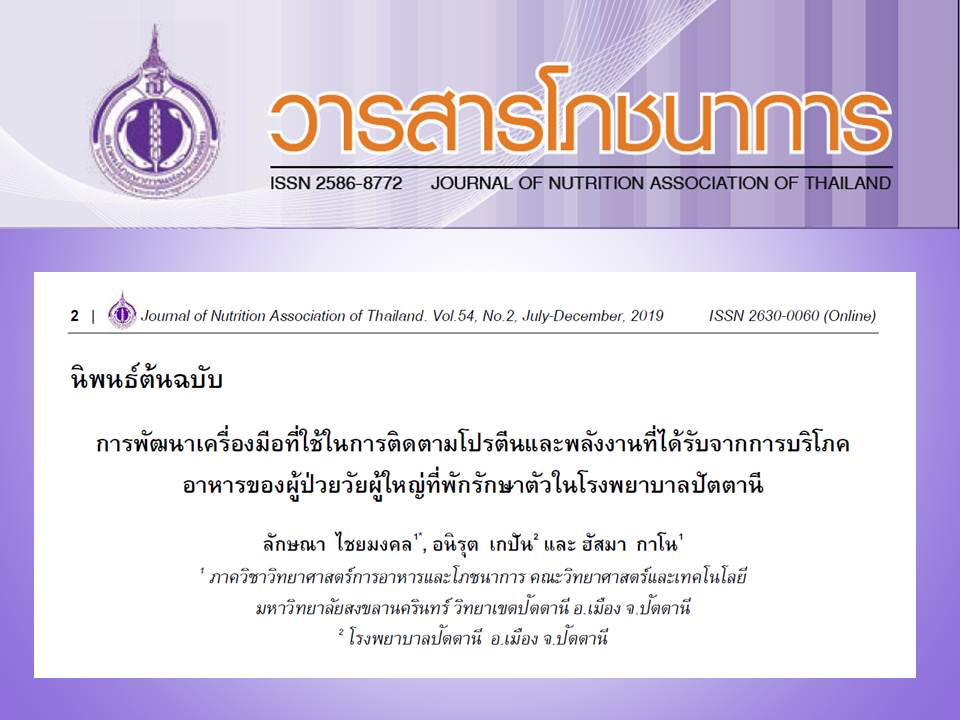Development of the Tool for Monitoring Protein and Energy Intake of Adult Patients in Pattani Hospital
Keywords:
Dietary assessment; Malnutrition; Pattani hospitalAbstract
Malnutrition in hospital is commonly found. It is caused by 2 main factors, i.e. inadequate dietary intake and having underlying chronic diseases which increase nutrient requirement. Thus, evaluation and monitoring daily energy intake is a means to prevent and control malnutrition in hospitalized patients. Presently, Pattani hospital does not have any simple dietary assessment tool which is appropriate for the hospital context. This study aimed to develop the simple tool for monitoring energy and protein intake; to compare the performance of the developed tool with the standard tool. Thirty patients aged 18-64 years in special room were included in the study. The 24 hour dietary intakes were recorded by weighing method for the foods served by hospital and estimated food record for the foods taken from outside hospital (reference method). In the evening of the same day, the patients were also asked to recall food intake in the past 24 hour according to developed food record form (studied method). INMUCAL-Nutrient v.2 program was used to analyze energy and protein in 24 hour dietary intake collected by the reference method while Food Exchange List was applied for analyzing energy and protein intake from the studied method. The results showed that the average energy and protein intakes derived by the studied tool were not significantly different from those derived by reference method. Correlation coefficient for energy and protein are 0.957 (p<0.05) and 0.830 (p<0.05), respectively. The agreement of the two methods in classifying groups by levels of energy and protein intake was moderate (kappa 0.644, p<0.05) and fair (kappa 0.333, p<0.05), respectively. In conclusion, the developed simple tool is appropriate for evaluation and monitoring energy and protein intake of patients in Pattani hospital.
References
Hiesmayr M, Schindler K, Pernicka E, Schuh C, Schoeniger-Hekele A, Bauer P, Schuetz T. Decreased food intake is a risk factor for mortality in hospitalized patients. The Nutrition Day Survey. 2006; 28(5):484-491.
Alliance to Advance Patient Nutrition. 2014. The problem in Malnutrition. 2014 [Cited 2018 May 8]. Access from: http://static.abbottnutrition.com/cms-prod/malnutrition.com/img/Alliance_Brochure_2014_v2.pdf
Budiningsari D, Shahar S, Manaf Z, Susetyowati S. A simple dietary assessment tool to monitor food intake of hospitalized adult patients. J Multidiscip Health. 2016; 9:311-322.
สมาคมนักกำหนดอาหารไทย. รายการอาหารแลกเปลี่ยนไทย. ใน: กินตามวัยให้พอดี. นนทบุรี: กองโภชนาการ กระทรวงสาธารณสุข; มปป. หน้า 76-86.
สถาบันโภชนาการ. โปรแกรม INMUCAL-Nutrients V2. นครปฐม: สถาบันโภชนาการ มหาวิทยาลัยมหิดล.
Matsuzaki E, Michile M, Kawabata T. Validity of Nutrient Intakes Derived from an Internet Website Dish-Based Dietary Record for Self-Management of Weight among Japanese Women. Nutrients. 2017; 9:1-13.
Crewson PE. Reader agreement studies. Am J Roentgenol. 2005; 184:1391-1397.
Masson LF, McNeill G, Tomany JO, Simpson JA, Peace HS, Wei L, et al. Statistical approaches for assessing the relative validity of a food frequency questionnaire: use of correlation coefficients and the kappa statistic. Public Health Nutr. 2003; 6:313-321.

Downloads
Published
How to Cite
Issue
Section
License
Upon acceptance of an article, copyright is belonging to the Nutrition Association of Thailand.

